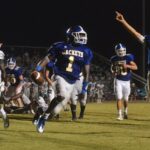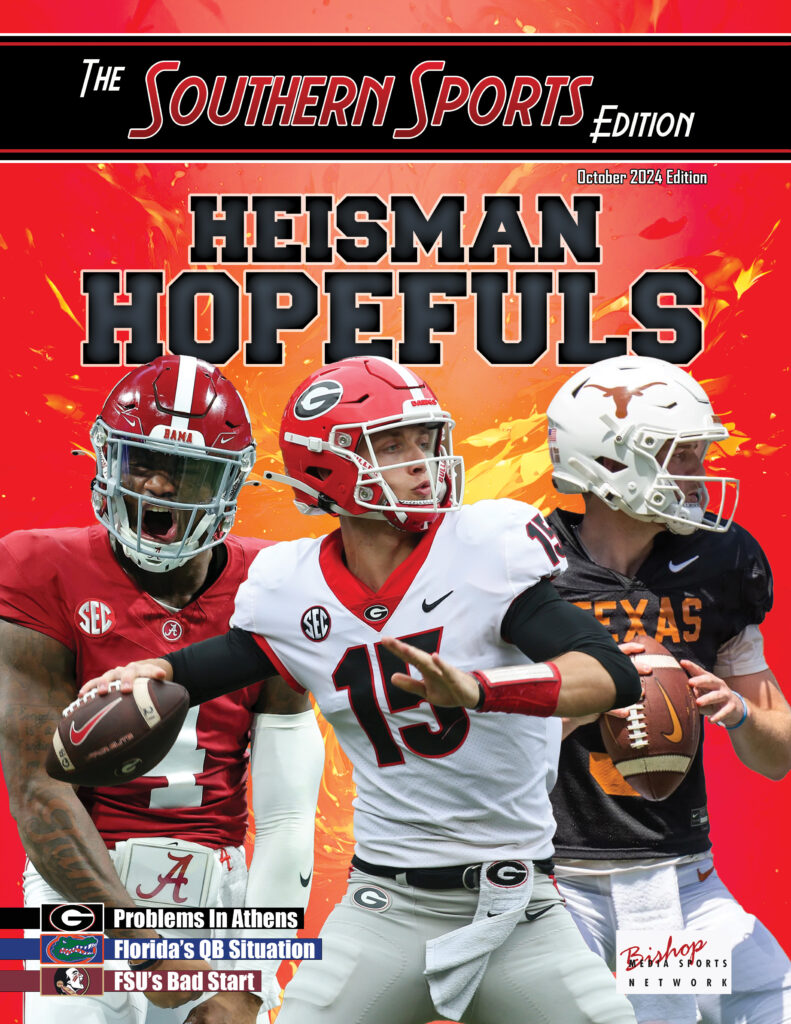Garrison Ryfun
Fear The Spear
 By: Garrison Ryfun
By: Garrison Ryfun
TheSouthernSportsEdition.com news services
Excitement is in the air in Tallahassee, Florida.
For the first time since 2017, Florida State is ranked in the preseason top ten.
Everything seems to be coming together for the Seminoles to have the breakout season they want to have in 2023.
It helps that Florida State has 87% of its production returning, #1 in the country according to ESPN.
It also helps that FSU brought in some highly coveted transfers to plug in holes, the #6 Transfer class in the country according to 247Sports.
How does this Florida State team perform in 2023? Let’s take a closer look at each phase of the game.
Offense: This should be the strength of this team that is returning starters like Jordan Travis, Johnny Wilson, and Trey Benson.
Last season Jordan Travis went 226/353 (64%) for 3214 yards 24 touchdowns and 5 interceptions. One of the biggest improvements season over season that I have ever seen at quarterback.
Trey Benson and Johnny Wilson both had breakout seasons after transferring to FSU.
Trey Benson, transferring in from Oregon, carried the ball 154 times for 990 yards and 9 TDs. Johnny Wilson, standing at 6’7″ 237lbs, had 43 catches for 897 yards and 5 touchdowns.
Both had adversity to overcome. Benson had a bad knee injury while at Oregon and Johnny Wilson had major drop issues while at Arizona State. Benson and Wilson, who defenses had issues stopping last year, are now going to be paired alongside even more weapons in 2023.
Enter Jaheim Bell, Keon Coleman, and Winston Wright.
Jaheim Bell, from Valdosta, transfers in from South Carolina and brings elite athleticism and tons of versatility to the FSU offense. Bell not only played tight end at South Carolina, but he was also deployed at running back last season after some injuries piled up.
Keon Coleman, transferring from Michigan State, had 58 catches for 798 yards and 7 touchdowns. Standing at 6’4, Coleman provides another long target for Jordan Travis to throw to and has really turned heads this fall camp.
Winston Wright is more your prototypical slot receiver, who sadly broke his leg last offseason in a car accident that was not his fault. Will he be back to his pre-injury self in 2023? If so, defenses will have a tough time guarding.
The offensive line should be the deepest it has been since 2013/2014 for Florida State, with at least eight guys still battling for starting spots right now: Jeremiah Byers, Bless Harris, Robert Scott, Maurice Smith, D’Mitri Emmanuel, Casey Roddick, Keiondre Jones, and Darius Washington. Some combo of those names will be the starting five.
I expect Florida State to have a top five offense when it is all said and done.
Defense: The defensive line will be the most talented group on this defense. The starting four of Jared Verse, Fabien Lovett, Braden Fiske, and Patrick Payton will give nightmares to opposing quarterbacks.
Jared Verse may be the best recruiting job Mike Norvell did in 2022, getting a guy who would have been drafted to come back and continue his development speaks volumes for this program.
The linebacker tandem of Tatum Bethune and Kalen Deloach is the most solid set of starters FSU has had in a long time, though the depth behind them is almost nonexistent.
DJ Lundy will be the next man up at the linebacker position and is also the starting fullback when FSU uses one on offense.
The defensive back room, now coached by Patrick Surtain, has not been publicly solidified starter-wise, but there are plenty of impressive options that FSU has to choose from. At cornerback, one starter will likely be All-ACC selection Fentrell Cypress who transferred in from Virginia.
Others fighting for spots at the other corner spot and nickel position are Renardo Green, Azareye’h Thomas, Jarrian Jones, and Greedy Vance Jr.
At the safety position returning starter Akeem Dent comes back while Shyheim Brown and Kevin Knowles battle for playing time at the other safety spot, and they will both likely play a lot this season.
I expect this defense to once again improve year over year under defensive coordinator Adam Fuller.
Special Teams: After struggling with kicking the last few years, FSU has a kicking competition going between Ryan Fitzgerald, from Colquitt County, and transfer Tyler Keltner. If the Seminoles want to win big this year they need a consistent kicker.
Punter Alex Mastromanno returns for his final season averaging 42.7 yards per punt in his career.
Conclusion: I am projecting FSU to go 11-1, with a loss to Clemson, in the new division-less ACC putting up big numbers on offense and setting up a pivotal ACC Championship game this December.
Savage Bears
 By: Garrison Ryfun
By: Garrison Ryfun
TheSouthernSportsEdition.com news services
Pierce County has been a powerhouse in 3A and 2A for years, winning their last state title in Fall 2020 while in 3A.
This year will be a rebuilding year for the Bears as they lose their top three rushers, starting quarterback, and three of their four top receivers from the 2022 season. I expect the Bears to bounce back fast as they seem to have in years past.
August 25th – Pierce vs Jeff Davis: I expect Pierce to win this game, though probably not to the margin they did last year. Expect some growing pains for the Bears but for them to win handily here.
September 1st – Pierce vs Metter: Pierce handily won over a decent Metter team in 2022. Look for a closer contest but still ultimately a win for the Bears, helping them get on track with a lot of new skill players.
September 8th – Pierce @ Liberty County: Pierce beat down Liberty County 47-6 last year, the worst loss Liberty had all season. Though I do expect some bumps in the road early in the season for Pierce, I have them winning this game against a team that will be hungry for revenge.
September 15th – Pierce vs Charlton County: The last non-region game of the season comes at home vs Charlton, another team they beat down last year 48-13. Charlton can be a solid 1A team, but I see Pierce really hitting their stride at this point in the season and picking up another win before region play starts.
September 22nd – Pierce @ Brantley County: The start of region play in 2023 for the Bears, the games that actually matter toward playoff seeding. There will be no drama in this contest between the Herons, the Bears will pick up their first region win in their first region game.
September 29th – Pierce vs Appling County: Appling County was one of two teams to beat Pierce last season, made it to the state semi-finals, and was also the winner of their region. With Appling returning more of their top talent, this game should favor the Pirates. Though I do expect Pierce to be back in gear by now, I think they drop this game to a tough Appling County team.
October 6th – Bye Week: This bye week comes at an opportune time after their first loss, and what will likely be a very physical contest.
October 13th – Pierce @ Toombs County: Toombs played Pierce very close last season in a 31-28 contest. In another rebuilding year I might call for an upset, but Toombs is losing their top two running backs from last season. Pierce will be in high gear at this point and will pull out a win at Toombs County.
October 20th – Pierce @ Windsor Forest: Windsor Forest has long been a punching bag in this area of high school football, with many teams making them a homecoming opponent over the years. Do not expect that to change this season, Pierce wins big in Savannah.
October 27th – Pierce vs Vidalia: Vidalia just missed the playoffs last season after losing to Tattnall County in October. This will be a team that will be hungry for that rematch. Between Pierce and Vidalia on the other hand, I have Pierce winning once again.
November 3rd – Pierce vs Tattnall County: Pierce vs Tattnall was not much of a contest last year as the Bears won 37-7. I think the game will be closer this year but I see Pierce winning this game to once again secure a home seed in the 2A playoffs.
I have a rebuilding Pierce County Bears team going 9-1, heading into the playoffs with a chance to make some noise.
Wave Of Terror
 By: Garrison Ryfun
By: Garrison Ryfun
TheSouthernSportsEdition.com news services
Glynn Academy finished the 2022 season with a record of 6-5, after losing a close game in the first round of the playoffs at Northside-Warner Robins.
Throughout the 2022 season, Glynn evolved as a team and really found their offensive identity in the latter half of the season with a focus on getting the ball into their best playmakers’ hands.
Two of those playmakers will be back this season in junior Greg Peacock and recent Georgia Tech commit, senior David Prince.
This shift in offensive philosophy took the Terrors from averaging 20 points per game in their first seven games to 31.5 points per game in their last four.
August 18th – Glynn vs Statesboro: Last year in Statesboro, the Terrors won in a 43-42 shoot-out to begin their season. Since that game, the Terrors found their offensive identity and ended 2022 looking like a better team. While the Blue Devils of Statesboro ended their season on a disappointing note, finishing the year 3-8. I have Glynn picking up the win at home this year.
August 25th – Glynn @ McIntosh County Academy: The MCA game in 2022 was a game that felt like Glynn had full control of, but Glynn never pulled away. MCA is a solid 1A team, but I have Glynn picking up the win in Darien.
September 1st – Glynn vs Camden County: Last year’s Camden County game felt like a wake-up call for the Terrors. They were shut out until a long run from Hank Noonan in the fourth quarter. I expect the game to be closer this year, but don’t know if they will pull off the upset.
September 7th – Glynn vs Baker County (FL): A part of the 2nd Annual Florida-Georgia Border War Classic, this will be a Thursday night game for the Terrors. Last year they took on Creekside (FL) in the first Border War, losing 21-20 in a torrential downpour. Baker County beat Richmond Hill in the Classic last year and seemed to be a solid team in their division in Florida. I expect this to be a tough contest for the Terrors, and the homer in me wants to say they’ll pick up a hard fought win before the bye week.
September 15th – Bye Week: Region play starts after this bye week.
September 22nd – Glynn vs Brunswick High: Glynn will be the home team this year for the City Championship. Glynn has now lost three in a row to Brunswick, but last year was the widest margin of the three with Brunswick winning 55-21. Glynn will need to dominate time of possession and get some key turnovers if they want to win this year’s City Championship.
September 29th – Glynn @ Effingham County: Last season, with worries of Hurricane Ian threatening to impact South Georgia, the game was moved up to a Wednesday. After a disappointing loss in 2022, I expect Glynn to be hungry to get after Effingham this season.
October 6th – Glynn vs South Effingham: Though the scoreboard does not reflect it, this may have been the game where Glynn figured out their offensive identity last year. I expect this to be a bigger win for Glynn in 2023.
October 13th – Glynn @ Grovetown: The game where it seemed to all come together for Glynn in 2022, winning 46-13. Though the drive to Augusta will be long, I expect Glynn to pick up the win again this year.
October 20th – Glynn @ Evans: After a comeback 25-22 win against Evans last year, Glynn kept their #3 seed hopes alive. I expect Evans will put up a tough fight after last year’s win.
October 27th – Bye week
November 3rd – Glynn vs Lakeside (Evans): Glynn finished up the regular season last year, with a 42-20 win over Lakeside (Evans). A team that had some young stars, I expect the game to be a little closer this year but for Glynn to get the win.
For now, I have Glynn going 8-2 with losses to Camden and Brunswick High. This team will have a chance to make a legitimate run in the playoffs, like a lot of past Rocky Hidalgo-coached teams have.
The Prince Of Terror
 By: Garrison Ryfun
By: Garrison Ryfun
TheSouthernSportsEdition.com news services
Glynn Academy Red Terror Senior wideout David Prince looks to make some noise in his final season as a Terror.
A four-year starter at the receiver position and standing 6 foot 4 inches 220 pounds, Prince is an imposing force at wideout.
Glynn Academy used his size advantage last year, as he became a regular jump ball target on the goal line for Quarterback Tyler Devlin. Prince’s wider catch radius makes him a perfect target for an inexperienced quarterback, which the Terrors will be rolling into 2023 with.
After starting high school with Louisville commit, TJ Lewis at QB and the stability of the last two years with Devlin, Prince will be looking to Ryan Schueneman as the new signal caller.
Schueneman, who played a similar role to David Prince last season, will now be the third starting quarterback to play with David Prince.
While out at practice, Prince and I talked about where he got his love of football from. He attributed it to watching his brothers play when he was growing up. Prince said after he started playing in the sixth grade he just fell in love with the sport.
Prince embraced the run-first identity of Glynn Academy’s offense in our interview saying: “Our number one thing is running the football; we ain’t ever going to change that.”
Despite playing in a run-first offense, Prince put up impressive stats last season, totaling up 28 catches for 607 yards and 7 touchdowns. That includes an explosive performance against Northside in round 1 of the playoffs last year, where he caught 3 passes for 120 yards and 1 touchdown.
Prince also played two ways last season, embracing being a team player and plugging in as an outside linebacker on defense. Prince told me he expects to play on defense again this season, once again playing outside linebacker for the Terrors. Another year’s worth of experience at the position, colleges are sure to take notice of both David Prince the tight end and David Prince the linebacker.
He talked about his goals and the team’s heading into 2023: “Get stronger, faster, and try to win a region championship. First day of spring we came out here with a mindset to win a region championship.”
Those kinds of goals are the right mindset to have and are warranted when you look at Head Coach Rocky Hidalgo’s track record. Coach Rocky Hidalgo has won a region title, or tied for one, five times in his career at Glynn Academy.
Coach Hidalgo himself had this to say about Prince: “He is an amazing kid, he is a lot of fun to be around. Anything he does is going to automatically be more energetic, it’s going to be more enthusiastic, and it’s going to be more fun. He’s just kind of naturally got one of those personalities. Great kid, got a good heart, and he’s a great teammate.”
Prince talked a little bit about the college recruitment process and told a story about receiving his first offer from Troy: “I was in class, [Troy coach Evan McKissack] texted me and asked if he could call me. So, I went somewhere and called him, he was telling me that I was going to be the first tight end that they offered.”
Prince went on to say the current state of his recruiting process felt “regular,” saying that it hasn’t changed who he is as a person. He is also interested in making the most of his coming college experience, possibly pursuing a business degree.
David Prince is a bright young man, who will turn some heads in high school ranks and with more college coaches very soon. Look for him to not only have a great senior year, but also be a steal for whatever college is lucky to get him.
Practice Game
 By: Garrison Ryfun
By: Garrison Ryfun
TheSouthernSportsEdition.com news services
On Monday last week, Hugh Freeze pitched the idea of playing a scrimmage in the Spring against another school: “Allow us to scrimmage somebody on a day.” Bringing up the attention and revenue it could bring, the decrease in risk of injury for both schools, and the benefits to seeing your guys in action against a different group of players.
Freeze even mentioned going against in-state teams like Troy, UAB, or Alabama State, to which new UAB Head Coach Trent Dilfer responded saying: “Pretty, pretty, pretty, pretty please.” He saw the benefits of live competition between teams and perceived it to be a benefit for his team as well. Dilfer mentioned the benefits of scrimmaging a team that is seen as superior to yours. Troy Head Coach Jon Sumrall was also on board with the idea saying: “I wouldn’t have a problem with it. I’d go play.”
This is not the first time the idea of scrimmaging against another school has come up in college football.
Dabo Swinney publicly pitched the idea in 2012, with then Michigan Head Coach Brady Hoke publicly jumping on the train not long after. If this is such a popular move with Head Coaches across the sport, then why haven’t we seen it up for vote already?
David Cutcliffe, former Duke Head Coach, lays it out well in this 2012 quote: “That’s an old idea, that’s a good idea, but that’s very difficult to get the NCAA to move in those regards. Your best chance is if you can prove you can make some money, because then you have a chance for the presidents and the ADs to vote in favor of it.”
At the end of the day college football is a business, while it may benefit the coaches to see other teams in live competition with their own, if it doesn’t generate decent revenue then it is likely dead-on arrival for any vote. Something I am sure coaches have thought about in their pitches behind closed doors, but you do not see a lot of in past public pitches for the idea.
Which is why Hugh Freeze’s pitch makes a lot of sense, it may ultimately come to nothing but he is hitting the right chords. The focus on scrimmaging with a more local university, making the organization easier and less costly. The revenue that an in-state scrimmage could drive in for both Alabama and Auburn; Hugh Freeze understands what the pitch has to be if anything will come out of it.
It is a similar pitch to one Mike Gundy made in the spring of 2021, where he pitched a spring game against Arkansas.
Once again, his public comments did not really hit on the revenue generating aspect of the conversation, and it likely went nowhere because of it.
Other coaches, like Mike Norvell, said they were open to the idea during conferences this week. Could there be another major push for spring scrimmages against other schools?
One of the other major roadblocks is that while most major college football coaches seem on board with the idea, there were some pretty powerful dissenters to the push in 2012, namely Nick Saban and Bob Stoops.
The former is now a coach in the XFL, and the latter has adapted and changed his philosophy with his style of offense in more recent years.
Could Saban, and more importantly Presidents and ADs, come around to the idea, or will this die down for another decade before another push happens again?
At The End Of The Rainbow
 By: Garrison Ryfun
By: Garrison Ryfun
TheSouthernSportsEdition.com news services
Just before Saint Patrick’s Day, Florida State and Georgia Tech announced they would play their 2024 season opener in Ireland as a part of the Aer Lingus College Football Classic.
This will be the 9th college football game played in Ireland, and one of the few times neither school playing in Ireland has had an Irish/catholic connection.
The Aer Lingus College Football Classic started in 2016 with a contest between Georgia Tech and Boston College, where the Yellow Jackets prevailed 17-14.
The Classic then took a five-season break and finally returned in Fall of 2022, with a matchup between Nebraska and Northwestern last season.
Now, The Classic seems serious about bringing a week 0 college football game to Ireland, with games set up to begin the 2023 and 2024 seasons.
Notre Dame, a more fitting brand for Ireland, is set to take on Navy to start the 2023 season at Aviva Stadium in Dublin, Ireland for The Classic.
There are pros and cons to the more increasingly common, neutral-site season openers – even ones that take place outside of the United States.
The biggest pros are for the student athletes and brand of college football in general.
The student athletes get to go and experience a different country and different culture, something many of which likely have never done in their lives.
The brand of college football also gets to be put onto display for Irish citizens, who have likely never experienced American college football in their lives.
The cons for a college football brand is losing a home game and the revenue that the local businesses around your school usually get with a home game.
In this case, the home team would have been Georgia Tech, and the game would have been played in Atlanta, Georgia.
This is one case where I do not think local businesses will be as hurt with a neutral-site game. Though there is said to be a large alumni base of Florida State graduates in the Atlanta area.
This kind of classic abroad is also done in the National Football League with five games already set to be played out of the United States in the 2023 season: with the Bills, Titans, and Jaguars playing in London and the Chiefs and Patriots both hosting games in Germany.
This is all done in an attempt to grow the brand of American Football abroad.
Something that may wind up failing, but as long as the governments of these countries continue to advocate for it – American football will be there to show off in all its glory.
The New Reality
 By: Garrison Ryfun
By: Garrison Ryfun
TheSouthernSportsEdition.com news services
In the upcoming age of super conferences in college football, major brands who are not a part of the Big Ten or SEC are trying to position themselves to be able to compete revenue wise with the brands in those conferences.
Currently, the Texas Longhorns and the Oklahoma Sooners are set to join the SEC in 2024, and the USC Trojans and the UCLA Bruins are set to join the Big Ten 2024. This is coincidentally the same year the 12-team playoff starts in college football, something that other Power Five conferences are likely happy about due to the massive changes happening in the landscape of the sport – with conference realignment.
Florida State’s latest board of trustees meeting gave insight to how teams are going to deal with this landscape going forward: Either the ACC gives more money to the teams that bring in more revenue, or those teams will do everything in their power to find a better situation for themselves.
Teams like Florida State, Clemson, Oregon, etc. will have to work out better deals for themselves. FSU AD Michael Alford pointed out that with the new television deals going into effect for the Big 10/SEC, schools like Florida State would be behind the curve by about $30 million annually.
This kind of gap will prevent these bigger brands from being able to compete for championships regularly, and in the coming months I expect more and more schools will start speaking about what needs to be done to stay relevant in college football.
This will, in all likelihood, create a very contentious relationship within conferences like the Pac-12, Big-12, and ACC. One way these conferences could help themselves out is by trying to create their own super conference.
The Big 12 is trying to lessen the impact of losing brands like Oklahoma and Texas by bringing in Brigham Young, Central Florida, Cincinnati, and Houston in Fall 2023 – a move that will not make up for the brand loss that will come after the 2023-2024 season.
Notre Dame will likely be a big target for those three conferences, as it is the only independent team left with a brand that big.
Teams may even be poached from one conference to the other, something that would mean the death of at least one power five conference. A thing that may be inevitable in the coming years, and may even help some of these conferences stay competitive or become super conferences themselves.
This struggle is not going to be solved overnight and its effects on football will likely not be seen for a few years.
There will be massive restructuring in the way some conferences are run and the teams that are within those conferences. All we can do as fans is sit back and hope your school understands their value as a brand within the sport.
The future of college football starts with changes made today. How will other big brands respond to the inevitable? There will be some fascinating off-seasons in the next couple of years, that’s for sure.
Kickoff
 By: Garrison Ryfun
By: Garrison Ryfun
TheSouthernSportsEdition.com news services
At the end of the first transfer period, two teams stand at the top of the transfer portal recruiting rankings according to 247Sports: LSU and Florida State.
Florida State and LSU started the season last year in a Sunday night thriller that ended with an extra point blocked by FSU.
Since that 24-23 win, both teams went on to have great regular seasons and both wound up winning a bowl sponsored by Cheez-It in Orlando. (LSU winning the Cheez-It Citrus Bowl and FSU winning the Cheez-It Bowl).
In an exciting week 1 rematch to start the 2023 season, both teams will pick up where they left off – in Orlando, at Camping World Stadium.
This neutral site matchup is sure to be another classic opening weekend game, with the winner having a great resume-building win for the final four-team playoff in 2023.
But how did these teams, who started the year unranked in 2022, become likely two preseason top ten teams? Good coaching and the transfer portal.
Names like Jayden Daniels for LSU or Jared Verse for FSU, both helped elevate the ceiling of the programs they transferred into in 2022.
Now heading into the 2023 season, with Florida State and LSU sitting on top of the transfer recruiting rankings let’s see who they brought in through the portal:
LSU:
Aaron Anderson (WR) from Alabama
Paris Shand (Edge) from Arizona
Jalen Lee (DL) from Florida
Bradyn Swinson (Edge) from Oregon
Denver Harris (CB) from Texas A&M
Jordan Jefferson (DL) from West Virginia
Zy Alexander (CB) from Southeastern Lousiana
Darian Chestnut (CB) from Syracuse
Jakailin Johnson (CB) from Ohio State
Ovie Oghofu (LB) from Texas
Omar Speights (LB) from Oregon State
LSU went hard after defensive lineman and cornerbacks, grabbing four of each during this cycle to help shore up holes. They also were able to grab a stud linebacker in Omar Speights to have in tandem with rising star Harold Perkins.
FSU:
Darrell Jackson (DL) from Miami (Fl)
Jaheim Bell (TE) from South Carolina
Kyle Morelock (TE) from Shorter University
Casey Roddick (IOL) from Colorado
Jeremiah Byers (OT) from UTEP
Keiondre Jones (IOL) from Auburn
Braden Fiske (DL) from Western Michigan
Fentrell Cypress (CB) from Virginia
Gilber Edmond (DE) from South Carolina
Tyler Keltner (K) from ETSU
FSU looked to add the lines of scrimmage, adding three offensive and three defensive linemen to their roster.
They were also able to plug a big hole at tight end, by bringing in two athletic college standouts.
They were able to secure the commitment from a transfer kicker, creating a competition there this offseason.
Finally, the biggest get for their class was likely Fentrell Cypress, a shutdown corner from Virginia – a piece the Noles have been missing since 2021.
In an age when questions are being asked about the sustainability of transfer portal recruiting, and whether or not it’s possible to win a championship with schools taking ten or more transfers a year – Florida State and LSU, teams using this newer model, will likely start the 2023 season in a top ten matchup that can have serious playoff implications.
Jason Bishop Show w Kipp Branch February 4
Shuffling The Deck
 By: Garrison Ryfun
By: Garrison Ryfun
TheSouthernSportsEdition.com news services
With the ACC going division-less in 2023, the championship will now be played by the top two teams in the conference, instead of the winners of each division.
Since the conference is going division-less, teams will now play what is described as a 3-5-5 schedule.
This means that from at least 2023 to 2026, ACC teams will have three primary opponents and a rotation of the other ten teams in the conference.
The ACC guarantees that through this new scheduling format, each team will have a home and away game against all 13 other teams in this four-year window.
Though not all that common, this will prevent a championship game played by a 7-5 or 6-6 winner of either the Coastal or Atlantic division.
Once again, the divisions will not exist anymore but every team will be locked into three specific opponents.
Here are the primary opponents for each team in the ACC:
Boston College: Miami (FL), Pittsburgh, and Syracuse
Clemson: Florida State, Georgia Tech, and NC State
Duke: North Carolina, NC State, and Wake Forest
Florida State: Clemson, Miami, and Syracuse
Georgia Tech: Clemson, Louisville, and Wake Forest
Louisville: Georgia Tech, Miami (FL), and Virginia
Miami (FL): Boston College, Florida State, and Louisville
North Carolina: Duke, North Carolina, and Virginia
NC State: Clemson, Duke, and North Carolina
Pittsburgh: Boston College, Syracuse, and Virginia Tech
Syracuse: Boston College, Florida State, and Pittsburgh
Virginia: Louisville, North Carolina, and Virginia Tech
Virginia Tech: Pittsburgh, Virginia, and Wake Forest
Wake Forest: Duke, Georgia Tech, and Virginia Tech
Notre Dame, though not an official member of the conference for football, will still play their contractually obligated five ACC opponents under this new system.
This move just makes sense for the health of the conference.
In the upcoming age of super conferences, with Texas and Oklahoma moving to the SEC and USC and UCLA making their move to the Big Ten, having the two best teams in your conference title game will only help with national perception for the top of your conference.
It will already be hard enough to convince teams like Florida State and Clemson to not look elsewhere during this era. Super conferences will only create more revenue, especially in the television space for their member teams.
This is a step forward, albeit small, for the conference, and could give fans some fun in-season rematches in the championship game for years to come.
The biggest problem the ACC has left is figuring out how to navigate college football in this upcoming era.
Convincing Notre Dame, whose contract with NBC expires in 2025, and another high-profile team to join the conference is the next big step the ACC has to take to remain relevant in the football space.


















